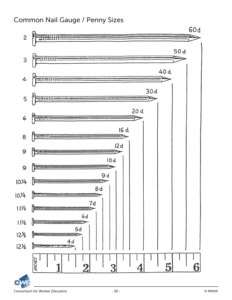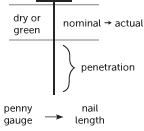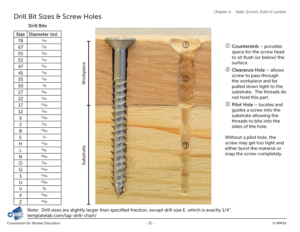We’re going to use a little fractions math to answer two practical trades math problems:
- Nail Penetration – How far will a nail jut out the other side of the wall? You might need to know this in case there are wires or pipes behind the dry wall you are nailing into. Or if you’re going to hang a heavy load on the screws.
- Screw Hole – What size drill bit will you need to make a hole for a screw? Only an amateur holds up a screw to a wall, and starts turning. You need to predrill for hanging a screw, so you need to know the right bit to put in your power drill.

Translating nail size to nail length
We name nails by penny size and gauge size. Gauge sizes are slightly different for common and box nails. We will do some examples in class on how to find the length of a common or box nail when we know its penny or gauge size.
Lumber: Nominal vs. Actual
Lumber standards, which includes 2′ x 4′, are governed by the National Institute of Standards and Technology (“NIST”) PS 20-20 American Softwood Lumber Standard. Like many RTMs, the question concerning nominal and actual dimension is actually a very complicated problem, mostly due to how much water trees and treated lumber can hold. The nominal size is the size we say, we name, when we describe it to other workers. “Go get me a two by four.” If we would put our measuring tape to that 2″ x 4″, you would see that the cross section is actually 1½″ x 3½″. Lumber at the local warehouse is “dry,” while planks from a mill might be “green,” or wet.
Nail Penetration

Now we can solve another one of those easy to say, difficult to answer, trades math problems. Remember what I said about learning how to solve the missing sides of a C shape? You need to find a way to take what’s in your brain, and create something physical, taking notes, color coding, … here’s a list of steps to help you answer a nail penetration problem. Using the handout:
- Convert nail size to nail length (s→l)
- Convert nominal to actual (n→a)
- SUBTRACT the smaller number from the bigger number (remember more/less)
NOTE: It doesn’t matter if the nail or lumber is the bigger number
Example: How far will a 5d common nail go through a 4″ x 6″ dry dimension?
- 5d → 1¾″
- 4″→ 3½″
- 3½ – 1¾ = 1¾
We will practice many of these in class. Always use the first number given for the lumber.
Translating screw size to diameter
When we are putting screws into a wall, we need to do something similar to what we did with nails. Instead of figuring out the length of a screw, however, we need to know its diameter, so we know how big of a hole we will need to make it easier to put the screw in. Once again, we will click on a link on the Top Menu, this time (back on the handout).
Screw Holes

There are three types of holes you can predrill for a screw:
- Countersink – the hole closest to the surface, it’s a little bit bigger than the screw diameter so the screw head will sit flush with the lumber or dry wall surface.
For this class a countersink hold is ⅛ more than the screw diameter. - Clearance – a hole just wide enough for the screw to drop into.
- Pilot – a hole slightly smaller than the screw diameter so that the treads will grab onto the wood.
For this class, a pilot hole is 1/16 less than the screw diameter
Predrilling screw holes
Now we can look at the other RTM problem: here’s a video to get a sense of what kind of problem we’re looking at.

Here are the steps to solving a screw hole problem:
- Convert screw size to screw diameter (s→l), using the Ruler link
- ADD ⅛ for a countersink hole, SUBTRACT 1/16 for a pilot hole
- Convert the answer to Step 2 to a screw bit size, by scrolling down to the bottom of Ruler link to see the Drill Bit table.
Example: What size drill bit do you need for a countersink hole for a 11 gauge screw?
- 11 gauge → 13/64″
- countersink → 13/64 + ⅛ = 21/64
- 21/64″ → Q bit
We will practice many of these in class, after which, … to the Learnbox!



